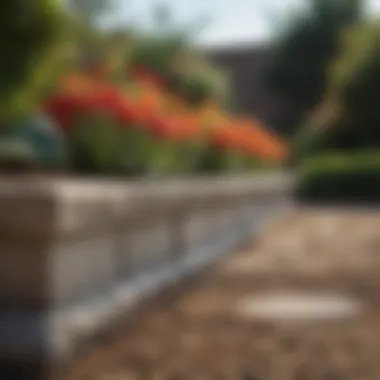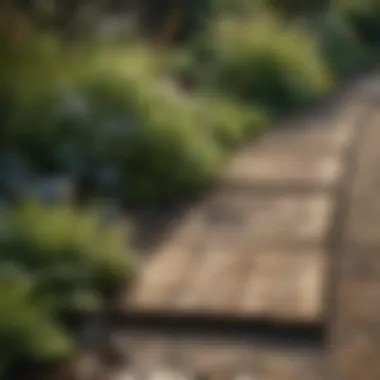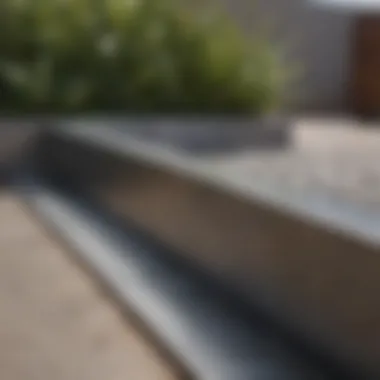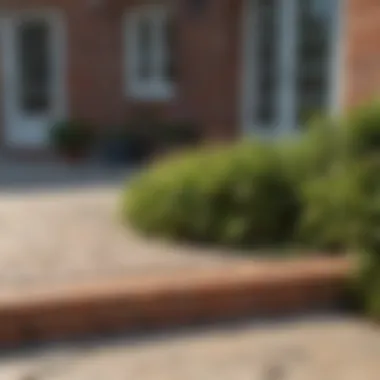Outdoor Edging Ideas to Enhance Your Landscape


Intro
Creating captivating outdoor spaces requires more than just selecting plants or furniture; it demands a thoughtful approach to how borders and transitions are structured. Outdoor edging plays an integral role in defining these spaces, combining aesthetics with functionality. This guide explores an array of outdoor edging ideas, detailing their benefits and applications. By examining various materials and designs, readers will be equipped to enhance their outdoor environments significantly. The goal is to achieve a perfect blend of style, practical use, and sustainability among the elements of outdoor decor.
Outdoor Decor Ideas
To elevate your outdoor aesthetics effectively, it is essential to consider various decor elements that play off one another. This section uncovers a collection of outdoor decor ideas that can work harmoniously with edging features. Each idea is meant to complement individual styles while ensuring practical usability.
Seasonal Inspirations
Adapting your outdoor space based on the changing seasons yields different opportunities for creativity. During spring and summer, consider vibrant flower beds bordered by natural stone edging. This approach provides a lively touch while clearly defining areas where flowers bloom. As autumn sets in, deep orange and rich red foliage can be contrasted beautifully with darker, more subdued edging materials. Finally, winter landscapes can benefit from evergreen plants framed by light-colored edging, creating a tranquil and inviting atmosphere.
Furniture Selection
Selecting outdoor furniture involves both comfort and style. Choose pieces that fit well within the edged area, maintaining visual balance. For example, a rustic wooden bench could be placed alongside a gravel pathway bordered by treated timber. Alternatively, sleek and modern metal chairs can align with contemporary stone edges, creating a more minimalistic look. Ensuring that the furniture complements the edging material will contribute to a seamless design.
Decorative Lighting
Integrating lighting into outdoor spaces can enhance both aesthetics and safety. Utilize LED strip lights along the edges of pathways or around flower beds. These lights not only illuminate the area but also draw attention to the defined borders. Understanding how light interacts with your chosen edging material—whether concrete, wood, or metal—will help guide your lighting choices effectively.
Plant Arrangements
The arrangement of plants in relation to edging can drastically affect the overall presentation of an outdoor space. Use low-growing plants along the edge to create clear boundaries and prevent encroachment from grass or weeds. In contrast, taller plants can be planted behind the edging, providing a layered visual effect. Consider using a mix of perennial flowers and shrubs for year-round interest.
Hardscaping Solutions
Beyond traditional edging, hardscaping provides practical solutions for managing outdoor spaces. Incorporating bricks, pavers, or stone can create defined borders that offer stability and visual appeal. Such materials are especially useful for managing soil erosion and defining pathways, making them both functional and attractive.
Sustainable Practices
Sustainability is an essential aspect of modern landscaping. Choosing eco-friendly materials for edging—such as reclaimed wood or recycled stone—contributes to environmental responsibility. Additionally, utilizing permeable paving can help ground water management by allowing water to filter through the edges, promoting a healthier landscape. Emphasizing sustainability respects the natural environment while also enhancing outdoor aesthetics.
"Thoughtful implementation of outdoor features reflects personal style while achieving functional landscaping."
By understanding and integrating these various components, outdoor environments can be transformed into cohesive, inviting spaces aligned with desired aesthetics.
Preface to Outdoor Edging
Outdoor edging is a critical element in landscape design. It serves multiple roles, from enhancing the visual appeal of gardens and pathways to providing structural support for both soil and plants. While some might consider edging merely decorative, its practical benefits cannot be overlooked. Proper edging can prevent soil erosion, control weed growth, and define spaces within outdoor areas.
Using edging to create clear boundaries contributes significantly to a well-organized garden. This not only allows for better plant management but also fosters a sense of order and beauty in outdoor spaces. In a high-end context, well-defined borders reflect a meticulous attention to detail. These elements of design can elevate aesthetic values while improving functionality. Choosing the right materials and designs for outdoor edging will go a long way in creating an inviting and sophisticated atmosphere.
"Outdoor edging takes the landscape from ordinary to extraordinary by infusing it with structure and style."
In the context of this article, we will explore different types of edging materials, aesthetics versus functionality, and various design ideas tailored to diverse tastes and preferences. Understanding the role that outdoor edging plays is essential for anyone looking to enhance their outdoor aesthetics while ensuring that such enhancements are practical and sustainable.
Types of Edging Materials
Types of edging materials play a vital role in enhancing the overall aesthetics and functionality of outdoor spaces. Selecting the right material can influence not only the design and beauty of a garden or pathway but also its durability and maintenance requirements. Each material has unique properties that cater to different styles and preferences. Understanding these characteristics helps in making informed choices that align with both practical needs and aesthetic goals.
Natural Stone Edging
Characteristics of Natural Stone
Natural stone edging is known for its stunning appearance and long-lasting nature. Each stone possesses distinct colors and textures, making it a popular choice for landscaping. The natural variations found in stone provide an organic feel to any garden. One key characteristic of natural stone is its durability. It withstands weathering and does not easily degrade over time, ensuring that your outdoor aesthetics remain intact for years. However, the weight of natural stone can make installation more challenging compared to lighter materials. This can be a consideration for those looking for a simple DIY project.
Installation Techniques


Installation techniques for natural stone require proper planning and tools. The stones often need to be cut to fit specific designs, which can involve using a wet saw or similar equipment. A gravel base is usually recommended to support the stones and help with drainage. This method ensures that the stones do not shift with time, providing a sturdy and reliable edge. While professional help can be desirable for achieving a polished look, some homeowners may prefer to take the DIY approach, which can also be fulfilling. The labor intensity might discourage those looking for a quick solution, but the rewarding result often compensates for the effort.
Brick and Paver Edging
Design Flexibility
Brick and paver edging stands out for its exceptional design flexibility. Available in various colors, sizes, and patterns, these materials allow for creative arrangements that can define outdoor spaces elegantly. This flexibility makes them suitable for formal gardens or rustic settings. Additionally, bricks can be laid in different patterns, such as herringbone or basketweave, which enhances visual interest. Though installation is somewhat straightforward, achieving a consistent and level finish may require a bit of extra effort, especially for those less experienced with landscaping.
Durability and Maintenance
The durability of brick and paver edging is another significant advantage. These materials are resistant to fading and damage from extreme weather conditions. They are also less prone to shifting or settling compared to other materials, which helps maintain defined borders over time. Maintenance typically involves occasional cleaning with a pressure washer to remove dirt and moss. However, if cracks develop, they may require resealing or replacement, which is relatively straightforward, but can be a downside compared to low-maintenance alternatives like natural stone.
Wooden Edging Solutions
Types of Wood to Use
When considering wooden edging solutions, it’s crucial to choose the right type of wood. Cedar and redwood are popular choices due to their natural resistance to decay and insects. These types have a beautiful appearance that fits well with many garden styles, offering a warm appeal. A notable aspect is that wooden edges can be easily shaped to fit various designs. Still, untreated wood may degrade more rapidly depending on soil contact and moisture levels, necessitating regular replacement or treatment.
Sustainability Considerations
Sustainability considerations come into play with wooden edging. Opting for reclaimed wood or sustainably sourced lumber minimizes environmental impact and adds character to your garden. While wood is biodegradable and can blend seamlessly into natural settings, its lifespan is predominantly determined by maintenance practices. Homeowners need to be aware that regular treatments or sealants are often necessary to extend the life of wooden edging, which may pose a challenge for those seeking low-maintenance solutions.
Metal Edging Options
Aluminum vs. Steel
Aluminum and steel offer unique characteristics for metal edging options. Aluminum is lightweight and resistant to corrosion, making it easy to handle and install. Steel, on the other hand, is sturdier and can be formed into various shapes but is also more susceptible to rust. The choice often depends on the project requirements. If a sleek and modern look is desired, aluminum might be the better option, while steel may appeal for more industrial designs. The installation process for both metals is relatively simple, though steel may require additional rust-proofing for longevity.
Corrosion Resistance
Corrosion resistance is vital in determining the longevity of metal edging. Aluminum, by nature, is highly resistant to corrosion due to its protective oxide layer. This quality allows it to weather harsh conditions without losing its structural integrity. In contrast, steel edging must be treated to prevent rust, especially in damp climates. This essential consideration can influence both the aesthetics and maintenance of your outdoor space, possibly making aluminum a more appealing choice for less maintenance-intensive applications.
Composite Materials
Benefits of Composite Edging
Composite edging combines the qualities of wood and plastic, creating a durable and attractive alternative for gardens. One notable benefit is its resistance to rot and moisture, making it suitable for various climates. Composite materials also often consist of recycled content, which is an environmentally friendly alternative. These materials are generally lightweight and easy to install, forming a practical option for those wanting to minimize labor. However, while they may resist fading better than untreated wood, they can be more expensive initially, which might be a consideration for budget-conscious homeowners.
Visual Appeal and Durability
Composite materials offer both visual appeal and durability. With options that mimic the look of natural wood, they can complement any landscaping design while providing superior endurance. Unlike natural wood, composites do not require frequent staining or sealing, which translates to lower long-term maintenance costs. However, certain composites can show scratches or wear over time, which might detract from their appearance. Weighing the aesthetic value against durability is essential to ensure selections meet expectations.
Design Ideas for Outdoor Edging
Integrating thoughtful design ideas for outdoor edging is crucial in enhancing both aesthetics and functionality in landscapes. The right edging can create defined boundaries between different garden sections and pathways, while contributing to an overall harmonious look. Importantly, these design choices can influence the visual flow of your outdoor spaces, which is essential for achieving an appealing environment.
Curved Edges for Soft Landscapes
Creating Natural Flow
Creating natural flow in landscaping involves using curves within your edging design. This aspect is vital as it leads the eye through the garden and makes the space feel more inviting. Curved edges mimic the organic shapes found in nature, which allows for a seamless transition between various elements in the landscape. This approach is popular because it softens hard lines, enhancing the visual impact. The advantage of this technique is its ability to create a more relaxed atmosphere in your outdoor space, making it an ideal choice for tranquil gardens.
Plant Integration
The aspect of plant integration is significant when considering curved edges. This involves positioning plants close to the edging to enhance the overall look while creating a lush environment. The key characteristic of plant integration is its support for biodiversity and color variety. It can lead to a more vibrant garden, offering benefits such as seasonal blooms and texture variation. However, it's crucial to consider that some plants may require more maintenance, which could impact the ease of garden care.
Straight Lines for Modern Aesthetics


Geometric Arrangements
Geometric arrangements stand out for their sleek, contemporary appeal. They bring a sense of order that is appealing in modern gardens. These designs use sharp edges and straight lines to define spaces clearly and exude a minimalist aesthetic. A well-executed geometric arrangement can highlight focal points within the garden and create pleasing symmetry. This could make them an excellent choice for urban gardening, where space is often limited and clarity is needed.
Minimalist Design
Minimalist design further emphasizes simplicity and functionality in outdoor spaces. This design approach reflects a commitment to functionality without unnecessary embellishments. It is characterized by clean lines and a limited color palette, making it widely appreciated in modern decor. The advantage is that it allows for easier maintenance and a reduced cluttered appearance, although one might argue it requires a careful selection of materials to avoid a sterile outcome.
Layered Edging Techniques
Blending Heights and Textures
Blending heights and textures is an approach that creates depth in landscaping. Using various materials and heights can draw attention and add intrigue to an otherwise flat landscape. This layering techniques enable you to showcase the visual interest that diverse textures can bring. Additionally, it offers practical benefits, like providing more substantial borders for plants. However, maintaining balance is crucial as too much variation might overwhelm the viewer.
Visual Contrast
Visual contrast is essential for highlighting specific areas within your garden. This involves juxtaposing different materials or colors to create dynamic impact. The key attribute of visual contrast is its ability to attract attention and guide the viewer's gaze. This technique is beneficial for emphasizing features such as flower beds or sculptures, but excessive contrast can create a jarring effect if not managed wisely.
Multi-Purpose Edges
Pathway Border and Sitting Area
Multi-purpose edges serve a practical role while enhancing beauty. They can define pathways and siting areas effectively, making gatherings more inviting. Their significance lies in combining structure with function, which is advantageous for maximizing space. However, careful planning is needed to ensure there is not too much overlap that results in cluttered appearances.
Drainage Solutions
Implementing drainage solutions through edging design is vital for maintaining the health of a garden. This aspect is about ensuring that water flows appropriately away from critical areas to prevent waterlogging. The main advantage of good drainage is its contribution to plant health and soil stability. Yet, depending on soil type, additional work might be necessary to reinforce drainage around gardens.
Practical Considerations for Implementation
Implementing outdoor edging requires a thoughtful approach. The selection of materials, design, and installation methods can significantly impact the final appearance and function of outdoor spaces. Practical considerations ensure that the edging not only enhances aesthetics but also serves a lasting purpose. Proper planning at this stage is essential for achieving desired outcomes.
Soil Preparation and Site Selection
Assessing Soil Type
Assessing soil type is an important step before installing edging. The soil's composition influences drainage, root growth, and stability. Different plants thrive in various soil types. For example, sandy soils aid drainage, while clay can hold moisture. Knowing these traits helps in choosing the right edging material. It could prevent issues like erosion or water pooling that can affect landscaping negatively. Consideration of soil type makes the implementation more effective.
Defining Edging Boundaries
Defining edging boundaries is essential for setting clear limits within a landscape. This practice ensures that the designated areas for plants or paths are well defined. Clarity in boundaries can aid in maintenance. Furthermore, it helps to prevent the encroachment of grass or weeds into flower beds. Precise boundaries create a more polished and organized appearance in your outdoor space. However, care should be taken to ensure that boundaries don’t restrict natural flow.
Cost Analysis of Edging Materials
Budgeting for Quality
Budgeting for quality is crucial in making decisions about edging materials. While it might be tempting to choose cheaper options, investing in high-quality materials can lead to long-term savings. Superior materials often require less maintenance and have a longer lifespan. Thus, it’s wise to allocate a reasonable budget to secure durable and aesthetically pleasing options. This choice can significantly affect the overall satisfaction with the final result.
Long-term Value vs. Initial Costs
Understanding the balance between long-term value and initial costs is fundamental. While some materials may seem affordable at first glance, their longevity could be questionable. Investing in materials that offer durability might incur a higher upfront expense but will likely prove economical in the long run. The long-term benefits of reduced maintenance and replacement can outweigh the initial investment, making this analysis a critical part of the planning process.
Installation Techniques
DIY vs. Professional Help
Choosing between DIY installation and professional help can influence the quality of the edging. DIY projects allow for creativity and can save money. However, they could lead to challenges if expertise is lacking. On the other hand, professional installation ensures that the edging is installed correctly. It may provide peace of mind but comes at an additional cost. Deciding on this aspect depends on the complexity of the edgings and the homeowner's level of comfort with hands-on tasks.


Step-by-Step Installation Guide
Having a step-by-step installation guide can simplify the process for those opting to do it themselves. This guide helps lay out all procedures transparently, providing clarity on each task. It usually covers soil preparation, material layout, and fixing the edging in place. This structured approach can help minimize mistakes and ensure the edging is both functional and visually appealing. A detailed guide makes it easy for anyone to follow along, regardless of experience level.
"Choosing the right edging material and installation method ensures your outdoor spaces reflect your vision while maintaining functionality."
Maintenance Tips for Outdoor Edging
Maintaining outdoor edging is crucial to ensure the longevity and aesthetics of your landscaping. Effective maintenance prevents degradation and enhances the overall impact of outdoor designs. Regular attention can help keep edges defined and functional, creating visual appeal while protecting your garden beds and pathways.
Seasonal Maintenance Routines
Seasonal maintenance involves checking the condition of the edging and performing necessary upkeep at different times of the year. This includes tasks like cleaning, inspecting for damage, and making repairs as weather conditions change. Regular seasonal tasks can prevent larger issues down the road, preserving the structural integrity of your edging materials.
Preventing Common Issues
Addressing Weeds
Weeds can pose a significant threat to the aesthetics and health of your garden. They compete with plants for resources, disrupting the ecosystem you aim to nurture. Addressing weeds early is a critical strategy for maintaining edging. Regularly removing weeds along edges creates a clean, defined boundary that enhances visual appeal.
The key characteristic of this practice is its immediate impact on garden appearance. Keeping weeds at bay is not just about looks; it also contributes to the health of your plants by ensuring they have adequate space and nutrients.
In practice, the unique aspect of addressing weeds lies in the types of removal methods you choose. Hand-pulling is often effective in smaller areas, while mulch or ground cover can suppress weed growth overall. However, these methods do require commitment to ongoing maintenance. Failure to manage weeds effectively can lead to an unkempt appearance, making timely intervention essential.
Managing Soil Erosion
Soil erosion can significantly impact the effectiveness of outdoor edging. It can weaken the structural support that holds the edging in place and lead to uneven surfaces. Managing soil erosion is essential for maintaining a healthy landscape. Adequate edging can help prevent loss of soil and keep your garden designs intact.
A crucial feature of erosion control is that it minimizes the risk of plants losing nutrients. By stabilizing soil, you not only protect your plants but also maintain the integrity of the edge itself. Techniques to manage erosion often include planting ground cover or using rocks to create barriers. While these methods can require a bit of planning, they yield long-term benefits for your garden’s health and appearance.
Restoration and Repair Techniques
Restoration of outdoor edging ensures that your investments remain aesthetically pleasing and functional. Regular checks on the condition of edging can reveal when repairs are necessary, preventing minor issues from becoming significant problems.
Replacing Damaged Edging
Replacing damaged edging is a straightforward yet essential aspect of maintenance. When portions of edging crack or break, it compromises not only the appearance but also the function of the outdoor spaces. Assessing damage regularly and replacing sections as needed can maintain the overall symmetry and order of your landscaping.
The highlight of this technique is its contribution to maintaining an appealing border. While it might seem labor-intensive, replacing a damaged section before it leads to broader problems protects your entire design’s integrity. The unique aspect of this task is that new materials do not always perfectly match the original; however, chosen correctly, they can create a cohesive look over time.
Reinforcing Stakes and Supports
Reinforcing stakes and supports is important for stabilizing edging materials. Over time, factors like soil movement and moisture can weaken these structures. Regularly checking and reinforcing stakes ensures the longevity and functionality of your landscaping.
The distinctive factor in reinforcement strategies is that they can often be done using simple tools and materials. By investing time in these tasks, you can avoid more extensive repairs later. Reinforcement helps maintain alignment and prevents materials from shifting, preserving the desired aesthetic. A benefit of this approach is that it requires less investment compared to complete replacements, making it a cost-effective solution.
Finale
The significance of concluding remarks in this article is multifaceted, encapsulating the essence of outdoor edging as it relates to enhancing aesthetics and functionality. Understanding the various materials and design principles discussed is vital for making educated decisions when considering outdoor edging solutions. As gardens and pathways become defined and visually appealing through responsible edging selection, the aesthetic value of any outdoor space increases considerably.
Summarizing Key Takeaways
In summary, outdoor edging serves critical roles that encompass both aesthetic enhancement and practical functioning. Key takeaways include:
- Diverse Material Selection: Knowledge of materials such as natural stone, wood, and composite options allows for tailored choices that complement individual landscape designs.
- Design Considerations: Employing design strategies, whether through curves or straight lines, can dramatically alter the perception of space, promoting a seamless integration with existing outdoor features.
- Maintaining Integrity: Implementing regular maintenance routines and being proactive about common issues can significantly prolong the life of edging elements, ensuring that they remain both functional and visually appealing over time.
Encouraging Thoughtful Choices
Encouragement toward thoughtful selection is pivotal for achieving balance between beauty and function. Individuals are advised to reflect on the following:
- Aesthetic Goals: Choose edging materials and designs that align with personal how you envision the outdoor environment, which directs not only to aesthetics but also to entire landscape coherence.
- Budget Alignment: A well-thought-out budget should account for long-term value rather than solely initial costs, promoting investment in quality materials that withstand wear and tear.
- Future Considerations: Future aesthetics and functionality should guide present choices about edging to minimize future adjustments or replacements.
Opting for solutions that embody both elegance and durability is key. Ultimately, thoughtful decision-making in outdoor edging is fundamental to achieving landscapes that resonate with style and practicality.







